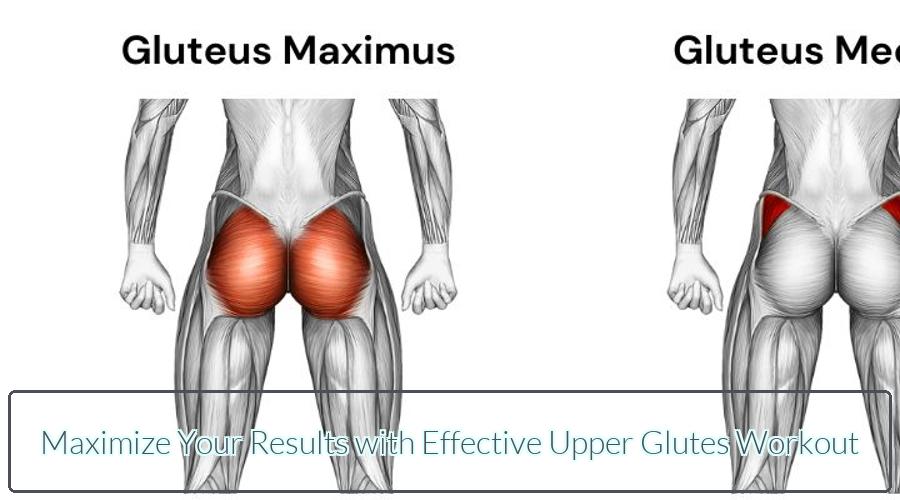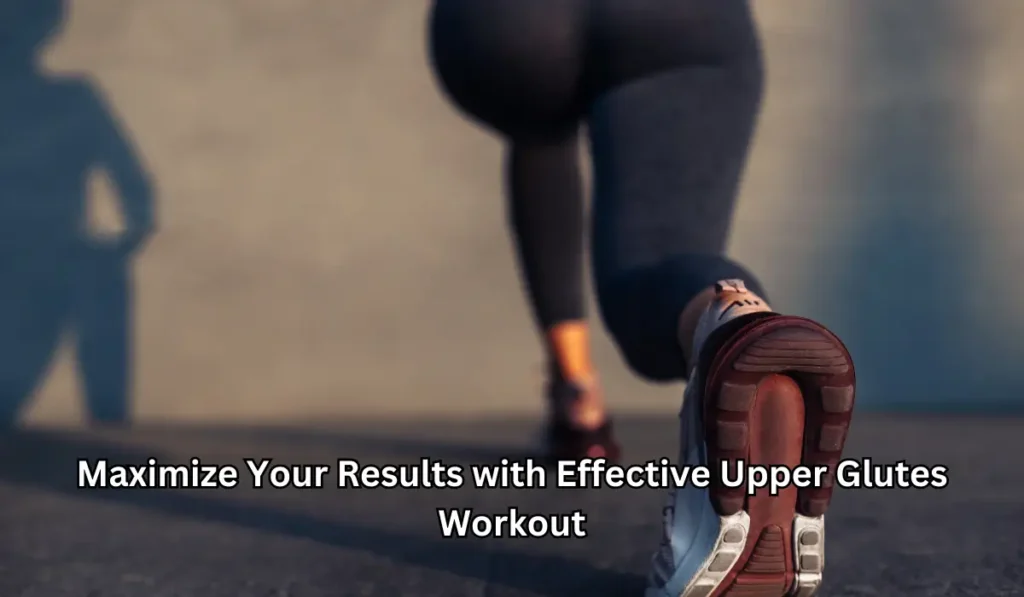
Maximize Your Results with Effective Upper Glutes Workout
When it comes to working out, many people focus on their abs, arms, and legs, neglecting one of the most important muscle groups in the body: the glutes. The gluteus maximus, in particular, is the largest muscle in the body, responsible for hip extension, thigh abduction, and thigh external rotation. A strong and well-toned gluteus maximus not only improves athletic performance but also helps prevent injuries and supports overall body alignment.
If you’re looking to sculpt and strengthen your gluteus maximus, you’re in luck. There are plenty of exercises and techniques that target this muscle group, and in this blog post, we’ll be sharing some of the best ones. From squats and lunges to hip thrusts and glute bridges, we’ll cover everything you need to know to get the most out of your upper glutes workout.
So, whether you’re an experienced gym-goer or just starting on your fitness journey, read on to discover how you can improve your glute strength and achieve a firmer, shapelier backside. Get ready to feel the burn!
Importance of the Gluteus Maximus Muscle
The gluteus maximus muscle, commonly referred to as the glutes, is the largest muscle in the body. It is located in the buttocks and plays a crucial role in various movements such as hip extension, thigh abduction, and thigh external rotation. While the glutes are often associated with aesthetics and having a toned backside, they are essential for proper posture, athletic performance, and injury prevention.
One of the primary functions of the gluteus maximus muscle is hip extension. This movement is used in activities such as running, jumping, and climbing stairs. A weak gluteus maximus can lead to compensations in other muscles, such as the lower back or hamstrings, which can result in pain or injury. Strengthening the glutes can help improve the mechanics of the hip joint and reduce the risk of injury.
The gluteus maximus also plays a significant role in maintaining proper posture. A weak gluteus maximus can cause the pelvis to tilt forward, leading to an excessive curve in the lower back known as lordosis. This can put added stress on the lower back muscles and lead to pain or discomfort. Strengthening the glutes can help maintain proper alignment of the pelvis and reduce the risk of lower back pain.
In addition to its functional benefits, the gluteus maximus is often associated with aesthetics. A strong and toned backside is a common goal for many people, and the glutes are a significant factor in achieving this look. Strengthening the glutes can help improve the shape and firmness of the buttocks, leading to a more defined and toned appearance.

Anatomy of the Gluteus Maximus
The gluteus maximus muscle is a large, triangular muscle that forms the buttocks. It is the largest and outermost of the three gluteal muscles, which also include the gluteus medius and gluteus minimus. The gluteus maximus muscle originates from the posterior ilium, sacrum, and coccyx bones, and it inserts into the femur bone.
The primary function of the gluteus maximus is hip extension, which involves bringing the thigh backward from a flexed position. The gluteus maximus also plays a role in thigh abduction, which involves moving the thigh away from the midline of the body, and thigh external rotation, which involves rotating the thigh outward.
The gluteus maximus muscle is innervated by the inferior gluteal nerve, which arises from the sacral plexus. This nerve provides motor function to the gluteus maximus and helps control its movements.
The gluteus maximus muscle is composed of both slow-twitch and fast-twitch muscle fibers. Slow-twitch muscle fibers are used for endurance activities, such as running or cycling, while fast-twitch muscle fibers are used for explosive movements, such as sprinting or jumping. The gluteus maximus contains a higher percentage of fast-twitch muscle fibers than other muscles in the body, which makes it well-suited for explosive movements.
The gluteus maximus muscle is also surrounded by several other muscles, including the hip flexors, hamstrings, and lower back muscles. Weakness or dysfunction in any of these surrounding muscles can impact the function of the gluteus maximus and lead to compensations or imbalances.
Read about Discover the Chadwick Boseman Workout
The Most Effective Upper Glutes Workout
Squats and Variations
Squats are one of the most effective exercises for strengthening the gluteus maximus. The basic squat involves standing with your feet shoulder-width apart and lowering your body down as if sitting in a chair, making sure to keep your knees in line with your toes. To target the upper glutes, you can try sumo squats, which involve a wider stance and a turned-out foot position, or single-leg squats, which require balancing on one leg and lowering your body down.
Sumo squats are great for targeting the outer thighs and gluteus maximus, as they place more emphasis on the hip abductor muscles. Meanwhile, single-leg squats require more balance and stability, and they’re excellent for developing unilateral strength in the glutes.
When performing squats, it’s important to maintain proper form and technique to avoid injury. Make sure to keep your back straight, your core engaged, and your weight distributed evenly across your feet. You should also avoid letting your knees collapse inward or pushing them too far forward past your toes.
Lunges and Variations
Lunges are another effective exercise for targeting the gluteus maximus. To perform a walking lunge, step forward with one foot and lower your body down until your knee is at a 90-degree angle, making sure to keep your knee in line with your toes. Push back up and repeat on the other leg.
Reverse lunges involve stepping backward instead of forward, while curtsy lunges require crossing one leg behind the other and lowering your body down. These variations put more emphasis on the outer glutes and can help improve balance and stability.
When performing lunges, make sure to keep your upper body straight and avoid leaning forward. You should also avoid letting your knee collapse inward or pushing it too far past your toes.
Hip Thrusts and Variations
Hip thrusts are a popular exercise for targeting the gluteus maximus. To perform a basic hip thrust, lie on your back with your knees bent and feet flat on the ground. Lift your hips up toward the ceiling, squeezing your glutes at the top, then lower back down and repeat.
Single-leg hip thrusts involve lifting one leg off the ground, while banded hip thrusts add resistance using a resistance band. These variations can help increase glute activation and strengthen the glutes unilaterally.
When performing hip thrusts, make sure to keep your feet planted firmly on the ground and avoid arching your back. You should also engage your core and avoid using momentum to lift your hips.
Glute Bridges and Variations
Glute bridges are another popular exercise for targeting the gluteus maximus. To perform a basic glute bridge, lie on your back with your knees bent and feet flat on the ground. Lift your hips up toward the ceiling, squeezing your glutes at the top, then lower back down and repeat.
Banded glute bridges involve adding resistance using a resistance band, while single-leg glute bridges require lifting one leg off the ground. These variations can help increase glute activation and improve balance and stability.
When performing glute bridges, make sure to keep your feet planted firmly on the ground and avoid arching your back. You should also engage your core and avoid using momentum to lift your hips.

Tips for Maximizing your Glute Workout
Maximizing your upper glutes workout is essential for achieving a stronger and more toned backside. Here are some tips to help you get the most out of your glute exercises:
- Maintain proper form and technique: Proper form and technique are crucial for targeting the gluteus maximus and avoiding injury. Make sure to keep your knees in line with your toes, engage your core, and avoid arching your back.
- Find the right weight and resistance: To effectively target the glutes, you need to use enough weight or resistance to challenge the muscle. However, using too much weight or resistance can lead to compensations and imbalances. Start with a weight or resistance that you can comfortably perform for 8-12 reps and gradually increase over time.
- Incorporate progressive overload: Progressive overload is the gradual increase of stress placed on the muscle over time. This can be achieved by increasing weight, reps, sets, or resistance. Incorporating progressive overload is essential for continued muscle growth and improvement.
- Rest and recovery: Rest and recovery are just as important as the exercise itself. Make sure to give your glutes time to recover between workouts, and incorporate rest days into your training schedule.
- Mix up your exercises: To prevent plateaus and keep your workouts challenging, it’s important to mix up your exercises regularly. Try different variations of squats, lunges, hip thrusts, and glute bridges to keep your glutes guessing.
- Incorporate cardiovascular exercise: Cardiovascular exercises, such as running, cycling, or swimming, can help burn fat and reveal the muscle underneath. Incorporating cardiovascular exercise into your routine can help you achieve a more defined and toned backside.
Read about Effective Upper Glutes Workout
Conclusion and Final Thoughts
Incorporating an upper glutes workout into your fitness routine is a great way to strengthen and tone the gluteus maximus muscle, improve athletic performance, and support overall body alignment. By targeting this crucial muscle group, you can improve your posture, reduce the risk of injury, and achieve a firmer, more shapely backside.
To maximize your upper glute workout, it’s important to incorporate a variety of exercises, including squats, lunges, hip thrusts, and glute bridges. Using proper form and technique, finding the right weight and resistance, and incorporating progressive overload can help you achieve maximum results. It’s also important to rest and recover between workouts, mix up your exercises regularly, and incorporate cardiovascular exercise to help burn fat and reveal the muscle underneath.
Whether you’re an experienced gym-goer or just starting on your fitness journey, an upper glute workout is a great way to improve your health, fitness, and overall wellbeing. By following the tips and techniques outlined in this article, you can strengthen your glutes, improve your posture, and achieve the strong, toned backside you’ve always wanted.
